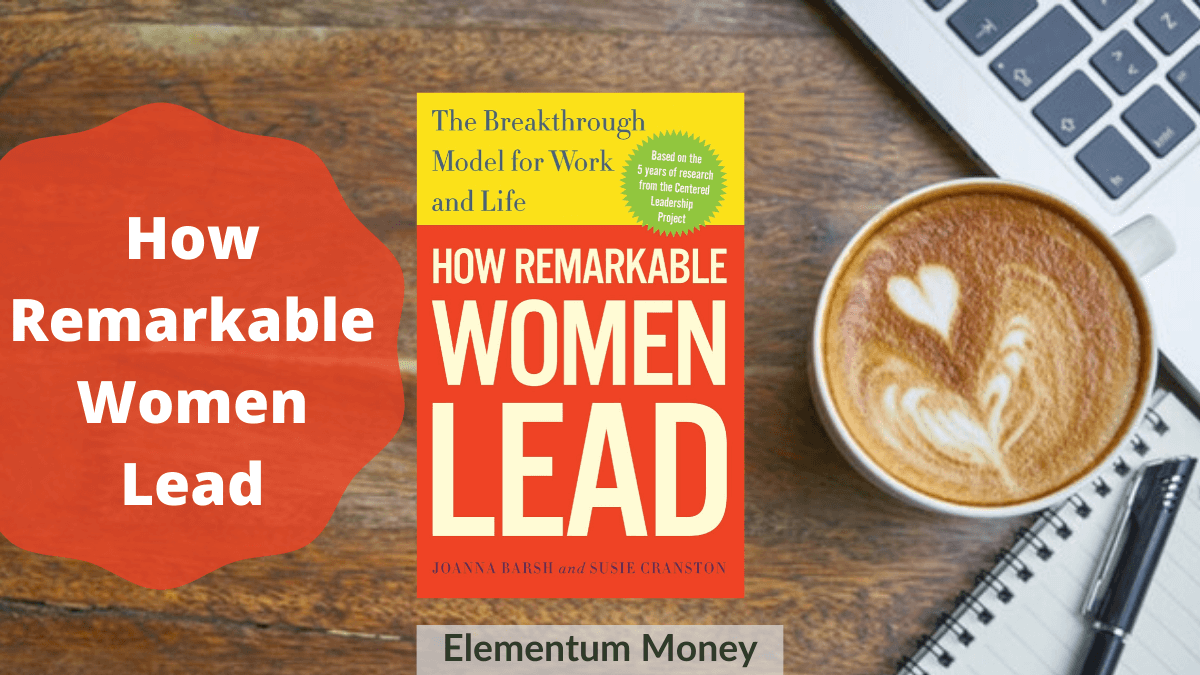Some movies leave you with dialogues that are life lessons to be quoted all through life. One such favourite dialogue for me is from the movie Spiderman – “With great power comes great responsibility”. At the early stage most of us look at leadership enamoured by the power, often forgetting the responsibility involved. Even with the title “How remarkable women lead”, the insights registered by the author were valid across genders. A lot of those insights are something to be honed and applied over the years on the path to leadership. No better time to start on those than now, I would say.
The main model of leadership
Even though the book is slightly dated, published almost 11 years ago, most of the conclusions are timeless. The book is a result of 5 years research at what they called the Centred Leadership Project. It involved talking and drawing insights from the journeys of twenty five amazing women leaders, mostly American with a smattering of women from other countries including one from India. All these findings were crystallized into a 5-pronged model which had conventional and unconventional aspects to it.
Each of the five factors are further divided into five learnings told through stories of 25 outstanding women leaders. So, let me briefly touch upon the five main aspects and follow it up with my five favourite stories of the twenty five that are featured in total.
1. Meaning
This part in some ways reminded me of Simon Sinek’s famous phrase “Start with why”. There is a hell lot of work required to become a successful leader. You can do that work only if you have the right passion and commitment to it. The path to getting there starts with having a strong meaning to why you do what you do. I could relate to it because personally, unless I feel for my work I turn into a work shirker. Find something that truly means something to you and also which you believe helps provide meaning to other lives.
2. Framing
This section in a way advocated objectivity and rational, clear-minded thinking. No better a time like this when the English phrase having it’s day in the sun is “unprecedented times”, to know just how difficult a task that is. But leaders consciously hone skills of zooming in and zooming out as the situation requires. One of the key learnings was the importance of knowing when to quit or change paths. Some women talked about the experience of being laid off and picking up the pieces from there, while trying to frame the situation positively.
3. Connecting
For a long time, I have viewed the word “networking” as pretty dirty. Why talk to people you don’t know for the possibility of a benefit you could derive from them. But, off late, I have realised it’s more about connecting on a human level. The authors look at a vast plethora of instances in this aspect. This included the role of sponsors, family-like love for your colleagues as well as giving to professional relationships.
4. Engaging
I found this section a little tricky to grasp but it seemed to have a mish-mash of messages. Of what I understood, it was really about taking initiative and action. If you want to be a leader, you have to find your voice. You have to be willing to take the first step without letting the fear of failure pull you down or lull you into inaction.
5. Energizing
Life is busy and for whatever steps we might have taken to bring about more equality for men and women, women are still wired to care more about the so-called balance. While most of the women interviewed admitted that the “balance” is an unattainable goal, they all talked about doing enough to be happy in both spheres. To be able to do that, an inescapable factor is energy. What I found fascinating was how the authors talk about deriving energy from work as well as finding active ways of recovery that complete the cycle.
Some of my favourite stories
When I started the book, I went in it for the stories and left with time-tested learnings. Below are five of my favourites, one from each of the above-mentioned spheres:
1. It all begins with meaning
The first chapter in the book starts with the inspiring story of Aminah Susannah Agbaje. Aminah is a woman who was inspired quite early by the show Case File which drew her to the thrill of problem solving in legal cases. Today, she runs her own law firm in Nigeria, which while it did not come easy has been an area of deep satisfaction for her. Only if you find meaning in your work can you sustain the devotion that it calls for to reach the pinnacles of success.
Without meaning, work is a slog between weekends. With meaning, any job can become a calling. By deploying your greatest strengths in service of a meaningful purpose that transcends everyday goals, you open your self to long-lasting happiness.
– How Remarkable Women Lead, Joanna Barsh & Susie Cranston
2. A matter of framing
The story of Emma Fundira, a black woman running her own financial advisory firm in white-dominated Zimbabwe was a story full of lessons. She talks about her inspiration of reframing things in a positive light, as she saw her mother rebuild her life after her parent’s divorce. Framing is about how you see a particular scenario. If you approach everything with a pessimistic outlook, while probably a good skill for risk assessment it does not bode well for life. Even in the path to leadership, there are many hurdles. Setting on them with a pessimistic attitude will just make them bigger and easier to trip over.
Good things and bad things happen to everyone. What makes the difference is how you work with this raw material of life. Over and over, the women leaders talked about opportunities and how they didn’t hesitate to take them.
– How Remarkable Women Lead, Joanna Barsh & Susie Cranston
3. Reciprocity forms relationships
Even though, biologically women are supposed to be better at building relationships thanks to the nurturing aspect, when it comes to networking most of us tend to take a back seat. So much of what the authors said here related to what I used to find distasteful. The fact that networking often involves casual and sometimes even transactional relationships. Women probably thrive more on deep friendships, full of meaning. Through the story of how Denise Incandela built up Saks Direct (Saks Fifth Avenue’s Internet business) the authors show the importance of building relationships. Initially, Denise bungles up but the presence of a boss who believes in her, gives her tough feedback and gets her to repair and build relationships within the organisation were all great elements in the story.
Don’t think of reciprocity as mechanical: perform a favor, wait, receive something in return, repeat. Keep in mind that you’re building a capability. The time between giving and receiving could be years, so reciprocity ought to become your regular habit. Sow those seeds today. Finally, don’t keep score. Not everyone will reciprocate in exactly the way you want. Sometimes you may never know how the gift is repaid. There will be people who take without giving; if you come up against a serial taker, just move on. For everyone else, you’ll enjoy the good feelings that come with helping others. That is a gift, too.
– How Remarkable Women Lead, Joanna Barsh & Susie Cranston
4. Crossing the line
In this bit, the authors tell us the story about Dame Stella Rimington, Great Britain’s first female Director General of MI-5! Through her story, the authors give the important lessons of finding your voice, taking ownership and saying yes to opportunities even if there is a small voice at the back of your head, asking “what if you fail?”.
You can learn to speak up for what you want, too. It takes knowing what you want. Surprisingly, the secret to success is usually just asking. Your own preconceived notions may be limiting our definition of what’s possible.
– How Remarkable Women Lead, Joanna Barsh & Susie Cranston
5. Boundless energy
Margaret Jackson talks about her years as the Non-Executive Director of Qantas Airlines in Australia. The seven-year period starting from the September 11 attack on World Trade Centre was stressful, to put it mildly. She talks about how she used a lot of physical activities to just get the built-up tension out. Finally, if you do not practice enough self-care, you will not have the oodles of energy required to traverse the challenges that almost any leadership job comes with.
Every other stressful period that I’d been through before taught me the principles that I applied in this period. You have to eat properly. You have to sleep properly. You have to have some time out. You have to exercise.
– How Remarkable Women Lead, Joanna Barsh & Susie Cranston
While the book has pearls of wisdom for leadership across genders, it still brought out the fact that it’s more difficult for women. There can be many reasons for it – a higher feeling of responsibility to home, guilt at practicing any self care, glass ceiling or even the inherent distaste for networking. Despite all this, women are making big strides and getting to those much hallowed top rungs. Reading books like these at any stage can give a boost to honing the skills to get us there.
The anecdotes are inspiring, the lessons are well-structured and overall I would definitely recommend giving this book a read. Have you read it already? Let me know in the comments below.





Leave a Reply